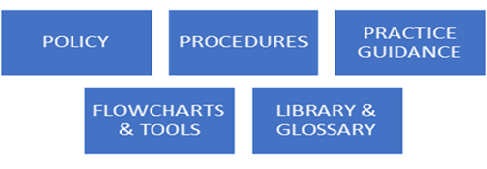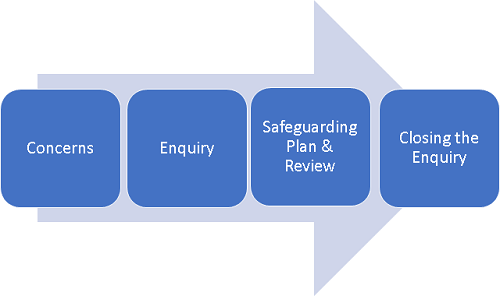Key Changes to Adult Safeguarding Policy and Procedures
1. Introduction
The (PPP) Policy, Procedures and Performance subgroup agreed to update existing Adult Safeguarding Policy and Procedures (P&P) to meet the requirements of the improvement plan and adult strategy.
The key deliverables were:
- To better reflect making safeguarding personal MSP;
- To change in focus from investigations to improved outcomes;
- Promote independence and reduce over protection.
MSP
|
A policy lead was appointed to make these changes to the P&P between October – December 2019. These changes have been signed off by the PPP, the Law Office and The Safeguarding Partnership Board.
These updates were completed in December 2019. These are due to go live in tri.x in March 2020 and become operational in April 2020.
2. Format of Policy and Procedures
The new P&P will be supported differently in tri.x, using the following format:

Separating the sections will make access and navigation simpler than our previous P&P. The new P&P has been reduced by approximately 60% when compared to the previous version. There remains an amount of detailed information, and this can be accessed via the index or search function within tri.x. Each chapter will be separated, and subject links can be easily followed.
The library section, guidance & tools will be updated and can be added to over time. Case studies and scholarly articles and other items can be sent to the SPB for inclusion.
3. Key Changes
There are number of changes throughout the policy and procedures. A summary of key changes is highlighted below.
Changes to Policy
- An adult at risk – definition - This now reflects the Care Act guidance.
Is a person (18 and over) who has care and support needs (irrespective of whether such needs are being formally met) and; is experiencing, or is at risk of abuse or neglect and; is unable to protect themselves because of their care and support needs.
We also use the word person, person at risk, and people quite deliberately in the P&P – as these engender a greater citizenship approach.
- Making safeguarding personal – is well referenced in both policy and procedures.
There are chapters on MSP for readers to understand and follow.
MSP means that safeguarding:- Is person led;
- Is outcome focused;
- Enhances involvement, choice and control.
It is important that conversations are had with the person to ensure their desired outcomes are identified and that safeguarding interventions are introduced to meet such outcomes. These outcomes should be measured at the end of the intervention. MSP supports personalisation, putting the person in control of shaping their intervention, this removes the new need to follow a process.
The key focus is on developing a real understanding of what people wish to achieve. This includes agreeing, negotiating and recording their desired outcomes, working out with them (and their representatives or advocates if they lack capacity) how best those outcomes might be reached, and the extent to which desired outcomes have been realised at the end point.
- Categories of abuse - have increased in number from 7 to 12 and include new categories marked with an asterisk *
- Physical abuse;
- Sexual abuse;
- Financial abuse;
- Discriminatory abuse;
- Emotional/Psychological abuse;
- Neglect (and acts of omission);
- Self-neglect;*
- Organisational/institutional abuse;
- Domestic abuse;*
- Modern slavery;*
- Hate and Mate Crime;*
- Female Genital Mutilation (FGM).*
The information relating to domestic abuse is significantly updated, with hyperlinks to the domestic abuse strategy. Forced marriage is referenced in this chapter.
There is detailed information relating to hate and mate crime, modern slavery and FGM which are also bolstered in the additional guidance section of the P&P.
PREVENT and CONTEST in response to countering terrorism and radicalisation is newly referenced.
The self-neglect policy and pressure ulcer protocol are being updated separately to this project and these are not complete at this time. -
Capacity & Self-determination (Jersey) Law 2016
The CSDL became operational in 2018 and is a significant piece of legislation – there are large but relevant chapters related to 'capacity and safeguarding' that readers will need to familiarise themselves with. -
Well-being, think family, and resilience building
These chapters introduce new concepts. -
Prevention
The chapters on prevention are improved and contextualised in relation to person-centred support, with individuals empowered to make choices and be supported to manage risks for themselves.
Changes to Procedures
Procedural changes are significant but are mapped out in a straightforward way.
The biggest change is that the procedures are navigable, so they are not process driven and that safeguarding interventions are responsive to the needs of the person being safeguarded. Exiting the procedures is permissible at any stage.
The new procedures support the delivery of individualised outcomes and removes the necessity to substantiate or not substantiate findings.
The procedures are structured with a four-stage approach:

The term raising a concern replaces raising an alert.
The term enquiry replaces investigations. Enquiries should be interpreted much more widely and should be seen as a vehicle for delivering personalised outcomes.
A safeguarding enquiry can encompass a range of required activities (for example) from conversations with people, to changes in care and support, to changes in systems or processes, to repairing or maintaining key relationships, to the access to social justice & recovery etc. An enquiry can also encompass different types of investigations, for example: criminal, regulatory or personnel related. An assessment of risk will be necessary in all cases.
There is a large chapter explaining enquiries to the reader.
We need to amend our thinking around safeguarding responses and the terminology that is often used. Our practice needs to shift to supporting adults at risk: and concerns being raised 'in relation to' or 'in respect of' adult abuse or neglect - and not be used 'against' a person or organisation. This is an important change of culture.
The roles and responsibilities of key organisations is detailed and linked to the P&P. In terms of safeguarding enquiries there are only two clearly defined roles: the safeguarding coordinator (a member of SAT safeguarding adult team – responsible for planning and oversight) and the enquiry officer (who may work for any agency – responsible for implementing planned activities and maintaining engagement with the person).
Planning discussions or meetings replace the word strategy (in standard cases)
We have introduced the step to undertake initial safeguarding visits (in many cases) recognising that people do not want to be called to meetings in offices to discuss their concerns with a variety of people. It is anticipated that we will have fewer (minuted) meetings and greater face to face work with people with this new approach. This should enhance the proportionality of our responses and will support the conversational approach that is recommended in MSP guidance.
The initial visit is an opportunity to inform on aspects of safety as well as establish rapport with the person at risk, ensuring that their voice is heard, and their desired outcomes are explored. Such visits will need to be planned, with relevant partners.
An enquiry report replaces an investigation report. These will need to be sufficiently and proportionally detailed.
We keep the partner report (template) as this is a popular form. However, these should be used by way of contributing information to an enquiry. If a partner agency is completing the enquiry themselves, then the enquiry report template should be used.
Outcomes discussions or meetings replace case conferences for concluding adult safeguarding interventions. As part of the review we must capture whether people's outcomes (identified at the outset and throughout) have been met or not. This is a must and should be part of casework responses and is not to be confused with the guided conversation that the SPB also capture by way of overall feedback. Please see box below in respect of capturing outcomes.
(Case conferences still exist - in multidisciplinary working or casework. This is outside of safeguarding).
Outcomes capture:
|
4. Organisational Abuse
We have introduced a separate pathway for enquiries into organisational abuse which will require a formal strategy meeting.
There is a chapter explaining the appropriateness of triggering an organisational abuse enquiry and the and the need to apply judgment in relation to the type, nature, degree and patterns & prevalence of concerns.
5. Large Scale Enquiries
A pathway for large scale enquiries e.g. Winterbourne View, Harold Shipman etc. will be developed outside of the P&P rewrite project.
6. DBS Referrals
This information has been updated.
7. Chairs for Objectivity & Independence
This chapter has been introduced on the back of a serious case review. There are occasions when the appointment of an independent chair may assist with the objective oversight and smooth running of certain cases.
8. Flowcharts and Tools
We have created new flowcharts and tools to assist navigation.
We have also added video links to SCIE (social care institute for excellence) materials in the categories of abuse sections of the policy to assist readers and learners.
9. Six Principles
The six principles of adult safeguarding are well referenced throughout the P&P and should be applied to each case that arises, with additional consideration to the ethos of making safeguarding personal.
- Empowerment: "Talk to me, hear my voice, what I have to say";
- Prevention: "Support me to be safe, now and into the future";
- Proportionality: "Work with me to resolve my concerns";
- Protection: "Work with me, to support me to be safe";
- Partnership: "Work together; with me. I am a partner too";
- Accountability: "Work with me, knowing you have done all you should".
| This summary of key changes captures the main changes we have made – however, the Policy and Procedures should be read in their entirety - and revisited periodically to ensure that readers stay on top of the information and apply learning in relation to specific cases as they arise. |

